
Anchers Hus is an art museum and gallery situated in the former residence of the painters Michael and Anna Ancher in Skagen, Denmark. Anchers Hus is located on Markvej in Skagen, Denmark. [1]

Anchers Hus is an art museum and gallery situated in the former residence of the painters Michael and Anna Ancher in Skagen, Denmark. Anchers Hus is located on Markvej in Skagen, Denmark. [1]

Michael Ancher (1849–1927) and Anna Ancher (1859–1935) were both central figures in the artist colony of Skagen Painters who lived and worked in the town during late 19th and early 20th century. After their marriage in 1880, Michael and Anna Ancher took up residency in the Garden House near Brøndums Hotel which was owned by Anna's parents. The Garden House is now a part of Skagens Museum. The house on Markvej was purchased in 1884. In 1913, a large annex was added to the property with studios, kitchen, living and bed rooms. [2] [3] [4]
They lived in the house for five decades and in 1913 expanded it with a studio annex designed by architect Ulrik Plesner (1861–1933) another member of the colony. The house now serves as a historic house museum and displays a large numbers of their own works and their personal art collection. In 1989 the museum was expanded with the neighbouring home of the Saxild family, which has been used for museum café, art storage and a historical photo exhibition. [5] [6] [7]
After the death of Michael and Anna Ancher in 1927 and 1935, respectively, the property was taken over by Helga Ancher (1883–1964) their only child, who owned it until her death in 1964. She left the house and all of its contents to a foundation. The former residence was restored and opened as a museum and visitor attraction in 1967, and became a part of Skagens Kunstmuseer · Art Museums of Skagen in 2014. [8]
In 1989 the Aage V. Jensens Foundation acquired the neighbouring Saxild House (Saxilds Gaard) and donated it to the museum. The property had been in the possession of the Saxild family from the late 18th century until 1959. The east wing housed a bakery from 1810 to 1919. [9]
Original furniture and paintings created by the Anchers and other Skagen artists are shown in the restored home and studio.
The Saxild House hosts offices and meeting spaces for staff members of the Art Museums of Skagen in one wing, while the other wing is used for a bakery and a cafe as well as a separate artist's studio.

Skagen is Denmark's northernmost town, on the east coast of the Skagen Odde peninsula in the far north of Jutland, part of Frederikshavn Municipality in Nordjylland, 41 kilometres (25 mi) north of Frederikshavn and 108 kilometres (67 mi) northeast of Aalborg. The Port of Skagen is Denmark's main fishing port and it also has a thriving tourist industry, attracting 2 million people annually.

Michael Peter Ancher was a Danish realist artist, and widely known for his paintings of fishermen, the Skagerak and the North Sea, and other scenes from the Danish fishing community in Skagen.
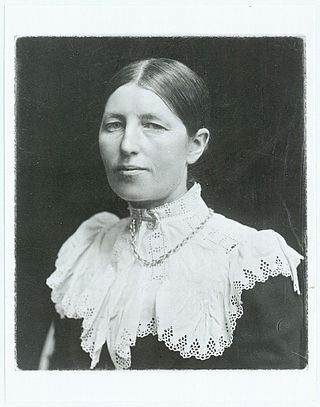
Anna Ancher was a Danish artist associated with the Skagen Painters, an artist colony on the northern point of Jylland, Denmark. She is considered to be one of Denmark's greatest visual artists.

Johan Frederik (Frits) Nikolai Vermehren, also known as Frederik Vermehren, a genre and portrait painter in the realist style.

Skagen railway station is the main railway station serving the town of Skagen in Vendsyssel, Denmark.
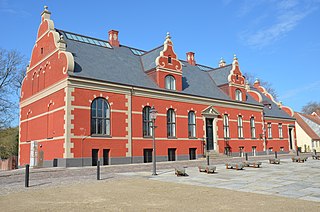
Ribe Kunstmuseum is an art museum in Ribe, Denmark.

Carl Locher was a Danish realist painter who from an early age became a member of the Skagen group of painters.
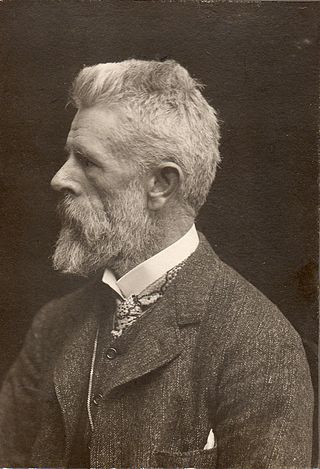
Laurits Regner Tuxen was a Danish painter and sculptor specialising in figure painting. He was also associated with the Skagen Painters. He was the first head of Kunstnernes Frie Studieskoler, an art school established in the 1880s to provide an alternative to the education offered by the Royal Danish Academy of Fine Arts.
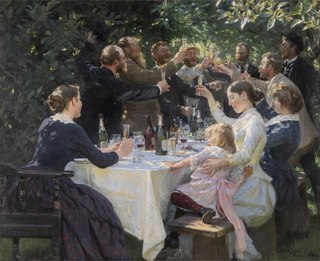
The Skagen Painters were a group of Scandinavian artists who gathered in the village of Skagen, the northernmost part of Denmark, from the late 1870s until the turn of the century. Skagen was a summer destination whose scenic nature, local milieu and social community attracted northern artists to paint en plein air, emulating the French Impressionists—though members of the Skagen colony were also influenced by Realist movements such as the Barbizon school. They broke away from the rather rigid traditions of the Royal Danish Academy of Fine Arts and the Royal Swedish Academy of Arts, espousing the latest trends that they had learned in Paris. Among the group were Anna and Michael Ancher, Peder Severin Krøyer, Holger Drachmann, Karl Madsen, Laurits Tuxen, Marie Krøyer, Carl Locher, Viggo Johansen and Thorvald Niss from Denmark, Oscar Björck and Johan Krouthén from Sweden, and Christian Krohg and Eilif Peterssen from Norway. The group gathered together regularly at the Brøndums Hotel.
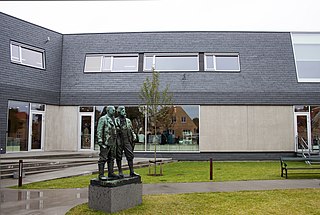
Skagens Museum is an art museum in Skagen, Denmark, that exhibits an extensive collection of works by members of the colony of Skagen Painters who lived and worked in the area in the late 19th and early 20th centuries. Important artists include Marie and P. S. Krøyer, Anna and Michael Ancher, Laurits Tuxen, Viggo Johansen, and Holger Drachmann. The museum also hosts special exhibitions. Its facilities include a café in the Garden House, an old building which for a while served as home residence and studio of Anna and Michael Ancher.
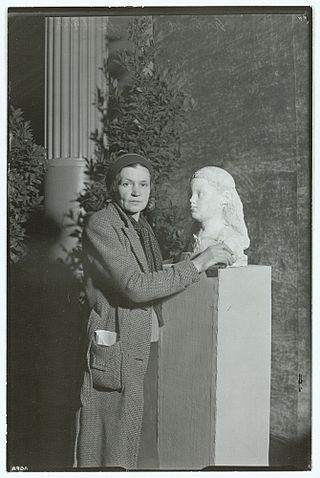
Astrid Noack was a Danish sculptor who specialized in the human figure, creating works such as the statue of Anna Ancher in Skagen, and her Standing Woman which was included in the Danish Culture Canon.

Ulrik Adolph Plesner, usually known as Ulrik Plesner was an innovative Danish architect who designed in a National Romantic style at the beginning of the 20th century. He is remembered in particular for his influence on the style of architecture practiced in Skagen in the north of Jutland.
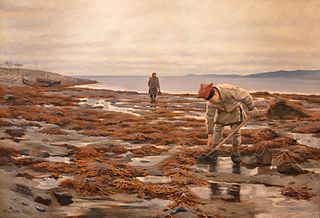
Wilhelm Otto Peters was a Norwegian painter who participated in the Modern Breakthrough in Nordic painting. He associated closely with the Skagen Painters in the early 1880s and was one of the first to paint the fishermen in Brøndums store.
Ella Christine Heide, née Brodersen, was a Danish painter who from 1908 painted in Skagen in the far north of Jutland.

Johannes Martin Fasting Wilhjelm was a Danish painter. Strongly influenced by Kristian Zahrtmann, he painted bright, colourful landscapes while travelling in Italy. His works also include religious paintings and portraits. He frequently visited the artists' colony of Skagen in the north of Denmark where he painted scenes of the dunes and beaches.

Peder Severin Krøyer painted various portraits of his wife, Marie Krøyer née Triepcke, a fellow Danish artist who was said to be one of the most beautiful women in Copenhagen. Norwegian-born Peder had met and painted Marie in Copenhagen but fell in love with her when they met in Paris in 1889. After a honeymoon in northern Jutland and Italy, the couple settled in Skagen on the northern tip of Jutland in 1891, joining the group of artists that became known as the Skagen Painters.

Harvesters is a 1905 oil painting on canvas by the Danish artist Anna Ancher, a member of the artists' community known as the Skagen Painters which flourished in Skagen in the north of Jutland in Denmark in the late 19th and early 20th centuries.

Helga Cathrine Ancher (1883–1964) was a Danish painter. As the daughter of Anna and Michael Ancher, she was closely associated with the Skagen Painters. Most of her paintings were of her family and friends in Skagen and of local landscapes.

Hunters of Skagen is a 1898 painting by artist Peder Severin Krøyer. It depicts a hunt on September 21, 1897. The work was sold to ARoS Aarhus Kunstmuseum in 1899 and has belonged to the museum ever since.